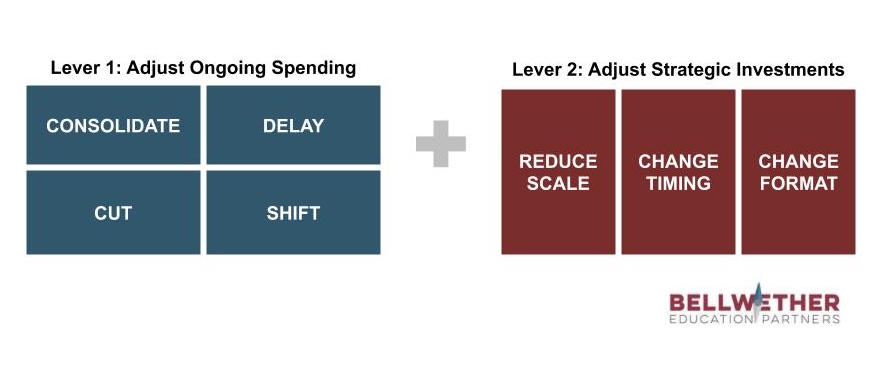On top of immense public health and learning challenges, school districts are grappling with critical questions about their financial future. What are the magnitude of state and local revenue shortfalls? What is the cost to fund new public health measures, social-emotional and mental health supports, and necessary academic interventions? Will there be additional federal stimulus funds to support education?
Even amid uncertainty, districts need to carry out proactive planning processes that ensure their spending remains aligned to their long-term (three to five year) strategic priorities, especially the initiatives and services that support students with the highest needs.
From our work supporting schools through earlier crises, we observed that that “urgent” budget cuts sometimes resulted in focusing too much on finding smaller short-term savings within district budgets. For example, if a district has a long-term goal around improving early elementary literacy outcomes, making cuts to literacy coach staffing may save needed dollars in the immediate term, but will put long-term outcomes at risk. By considering budget cuts in the context of strategic priorities, leaders can minimize the adverse impacts of funding shortfalls on students while maintaining momentum towards their desired future state.
Yesterday, my colleague Jenn answered common questions about whether and how changes in state revenue will impact school funding. If those changes in state revenue do have negative impacts, districts will likely need to make cuts to their operating budgets. Today we propose that districts need to both consider reductions to ongoing spending and adjustments to strategic investments. Leaders can combine the set of options outlined below to mitigate financial loss in a way that minimizes adverse impact on students, especially those with the greatest needs.

1. Reductions to Ongoing Spending
Districts will need to consider spending reductions that minimize the negative impact of COVID-19 on their strategic direction.
Consolidate
- Increasing class sizes
- Consolidating underutilized school buildings or closing sub-scale schools
- Combining non-teacher roles and responsibilities at the school- and central-office level
- Sharing program costs across buildings
- Example : A school district decides to combine three under enrolled magnet programs into one
Delay
- Delaying capital investments
- Delaying scheduled maintenance
- Delaying compensation increases
- Example : A district decides to delay scheduled maintenance for central office buildings during work from home
Cut
- Cutting field trips and extracurriculars
- Reducing central office staffing and expenses
- Cutting transportation (while remote)
- Reducing facilities maintenance and operations (while remote)
- Example : A school district decides to cut central office staff by 10%
Shift
- Reallocating professional development to focus on remote instruction
- Shifting materials budget toward digital curriculum
- Altering food services spending to support food distribution services
- Example : A school delays rolling out a new curriculum and reallocates spending to professional development and remote programming
Derek Richey, Chief Financial Officer at Cleveland Metropolitan School District, notes: “We have managed budget challenges over the past two schools years by reducing or restricting central office spending and avoiding ‘cuts’ to schools, kids, and classrooms. The scope of the COVID-19 impact extended some of those restrictions to schools, but we continue to strive to minimize the impact on schools and ‘bear’ the reductions in central office. As this year has progressed, it is increasingly clear that we will not be able to shelter schools from reductions without additional support. We have spent or encumbered nearly all of our federal stimulus funds and still need to plan for future investments in 1:1 devices and residential Internet for our disconnected communities.”
2. Adjustments to Strategic Investments
Districts should also review their long-term priorities to see if they need to reduce the scale, change the timing, or change the format of the investments planned to enable these goals. This does not necessarily require changing a district’s strategic priority itself, but may require adjusting the timing of the expected outcomes. For example, if investments in literacy coaches are delayed, districts will need to identify the potential impact on projected early literacy outcomes.
Reduce scale
- Piloting investment in a grade level or subject
- Concentrating investment in highest need schools
- Example : A district originally planned to place literacy coaches in every elementary school, but due to budget cuts, they put coaches in the 20 lowest performing schools or assign one coach to cover three schools
Change timing
- Delaying the launch of a new strategy to later years
- Moving up investments that have become higher priority
- Example : A district planned to become 1:1 in the next five years, but now needs to make that investment in FY21
Change format
- Utilizing tech to deliver programs moving forward
- Reconceptualizing how to achieve a strategic goal
- Example : A district wanted to ensure AP access at each high school, but rather than hiring additional FTEs (as planned), they leverage capabilities built during distance learning to deliver AP coursework virtually
It’s too early to know with certainty how school districts’ budgets will evolve in the next 1-3 years. But district leaders need to think now about how short-term, immediate budget reductions may impact longer-term strategic priorities. With care, districts can make plans that keep students’ short-term needs and long-term outcomes front and center.
If you’re a district that needs financial planning support, contact us . You can also follow along on our series “The Looming Financial Crisis?” for more resources.